You will need:
- One cardboard pizza box
- Aluminium foil
- Clear kitchen Plastic wrap
- One wooden Kebab Stick
- Black plastic garbage bag
- Scissors
- Sticky tape
- Glue
- A box cutter may be useful, but only use one if you have the help of an adult
- Thermometer
- Chocolate, or butter
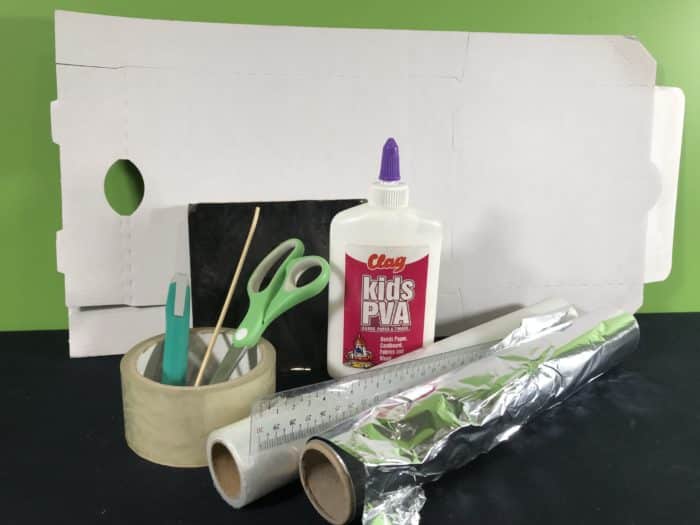
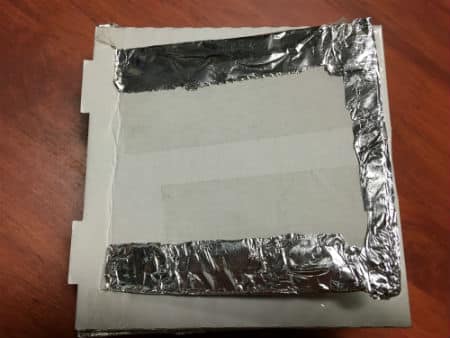
“Wrapped Aluminium foil around the pizza box solar oven lid”
Cut out a sheet of Aluminium foil so that it is larger than the cardboard flap you have made in step one. Wrap this Aluminium foil around the inner side of this flap so that it faces downward into the pizza box. Use the tape to secure the foil. The foil will be your mirror to reflect the sunlight.
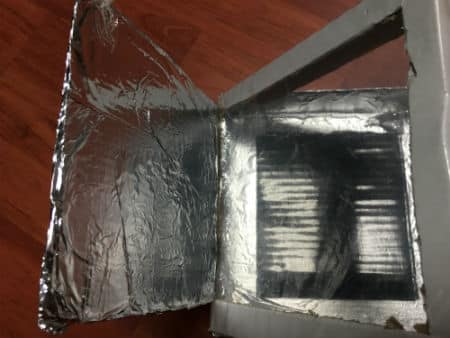
“Top lid covered in foil with clear plastic film across window opening”
Another option is to simply coat the entire inside of the pizza box with the black garbage bag. In fact, this would make a good variable test with your students. Which design performs better?
Place clear plastic kitchen film across the opening of the top lid and secure this with tape.
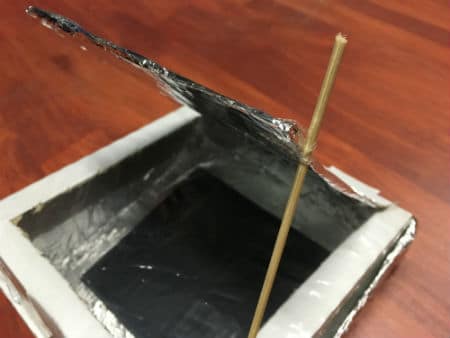
“Kebab stick supporting pizza box solar oven lid: note tape loop on lid for adjustments”
Use the wooden kebab stick to support the Aluminium covered top lid flap by pushing it into the pizza box and the lid. It can be handy to create a loop of sticky tape off the edge of the top lid flap as that way you can use this as way of adjusting the angle of the lid, this is great for changing the angle of the ‘mirror,’ as the sun moves.
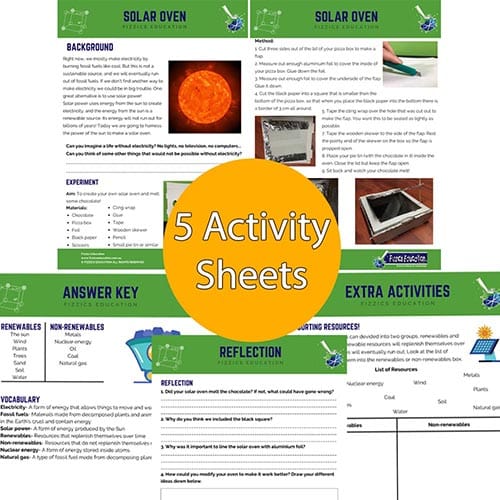
Go further – buy 5 x student activity sheets as extension worksheets.
This student science booklet has been created by experienced science educators from the Fizzics Education team.
Use these student worksheets as blackline masters for your science class!
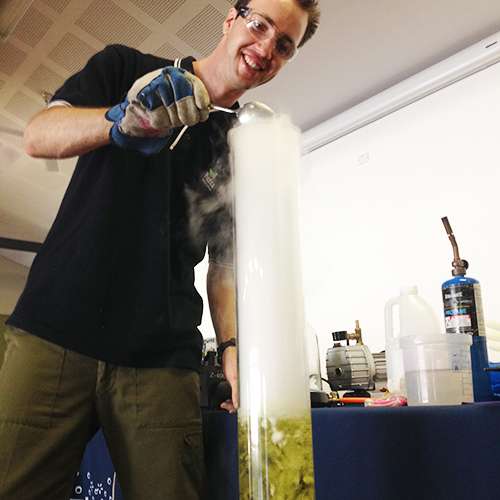
School science visits since 2004!
– Curriculum-linked & award-winning incursions.
– Over 40 primary & high school programs to choose from.
– Designed by experienced educators.
– Over 2 million students reached.
– Face to face incursions & online programs available.
– Early learning centre visits too!
Why Does This Happen?
Solar ovens work by trapping heat energy from the Sun. In this experiment you were able to direct heat energy from the Sun through the clear plastic film using the reflective Aluminium foil flap. Once the heat was inside the pizza box, the black plastic garbage bag absorbed the heat energy and the air temperature within the pizza box rose. For best results you would have found that you need to move the box slightly to compensate for the Sun’s position changes as our Earth spins. You could also further insulate the outside of the pizza box to avoid heat loss from conduction into the ground and surrounding area.
Application
Solar ovens have been around for a long time, in fact you can buy commercial solar cookers from some boutique suppliers! The best solar cookers have means of concentrating the Sun’s radiant heat energy into an area which is dark to absorb as much heat as possible and are well insulated to avoid heat loss. Solar cookers still have use in modern times, especially in areas where people don’t have ready access to electricity, wood or gas cookers. There has been some revival of this technology as a response to environmental concerns of greenhouse gas emissions too, plus they make great camping gear. Of course, in cooler environments you’ll have a much more difficult time!
Classroom activity sheets for this experiment
Create, reflect & extend!
From liquid nitrogen shows to hot & cold workshops, we’ve got your unit on properties of materials covered!
Get in touch with FizzicsEd to find out how we can work with your class.
Renewable Energy
Years 3 to 6
Maximum 30 students
Workshop (NSW & VIC)
60 or 90 minutes
Online Class Available
STEM Full Day Accelerator - Primary
Designed from real classroom experiences, this modular day helps you create consistently effective science learning that directly address the new curriculum with easily accessible and cost-effective materials.
Hands-on Kids Science Party
>20 hands on science experiments
Gigantic bubbles
Slime making
Professional science show
From $395 inc. GST

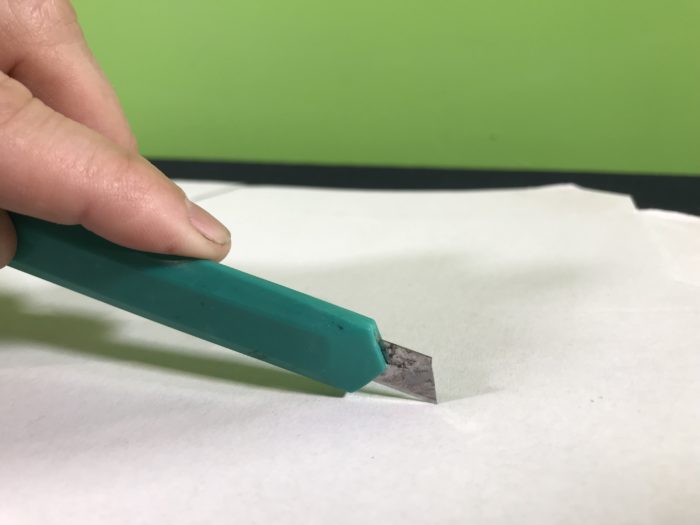
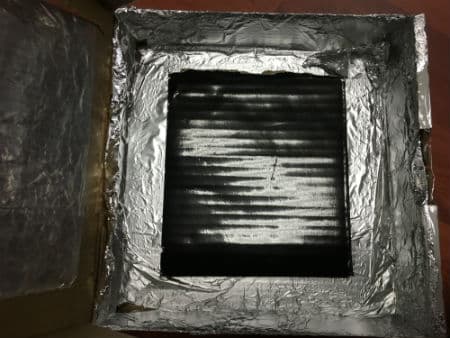
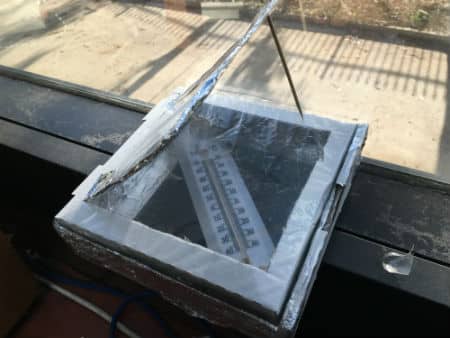
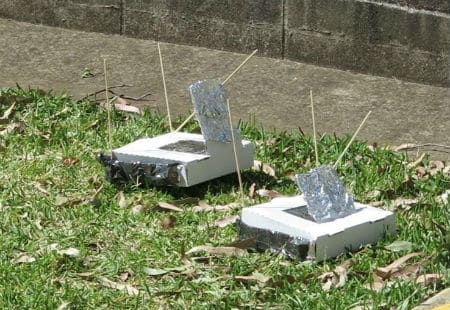




























good
Very cool. It really works and we cooked pizza’s in it. It took a bit of time but we got there.
Awesome. Portable so you can take on camping trips as like an oven